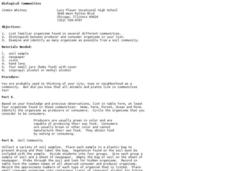Curated OER
And Now for Something Completely Different...
Young scholars identify organisms that are typical a part of a hydrothermal vent. They examine why hydrothermal vents are short-lived.
Curated OER
Where Did They Come From?
Students explain hydrothermal vents and the process in which species and the hydrothermal vents become isolated.
Curated OER
Looking for a Walrus
Students perform the "Looking for a Walrus" song while role-playing to show their awareness of walrus adaptations. They study the words and add motions to the song.
Curated OER
Build A Model of the Water Cycle
Students identify and describe the steps in the water cycle. They discover the sun as the source of the cycle. They work together to create their own water cycle model.
Curated OER
Let's Think About Water
Students explore the different forms that water can take and conduct simple experiments to demonstrate some of its properties in each state. They watch a short video that illustrates some of these concepts.
Curated OER
Boats Graph
Learners read from the Bible about the travels of Paul, particularly the boat rides. They trace Paul's travels on a map of Asia Minor. Students review a field trip they took and make a graph showing the numbers of each type of boat they...
Curated OER
Great Salt Lake Introductory lesson
Fourth graders explore the Great Salt Lake. Using the internet, they identify web sites that contain information on the Great Salt Lake. After researching the website, 4th graders answer questions and list information they collected...
Curated OER
What Is A Dinosaur?
Learners use the question of "What is a dinosaur?" in order to establish the context for a class investigation. They use a variety of resources in order to gather information. Students compare and contrast the similarities or differences...
Curated OER
Shark Attack
Students examine the white shark. They think critically about a set of shark facts and predict whether the statements are true or false. Students describe a year in the life of a white shark living in the Red Triangle. They create a...
Curated OER
John Fitch: Pioneer Steamboat Inventor
Students explore the transportation revolution brought about through the use of steam power to move boats over water. They practice note taking skills by taking notes from an article.
Curated OER
Interest Survey
In this science and social studies worksheet, students complete a survey about their interests. Students check each subject that they are interested in, such as killer whales, Thomas Edison, and magnets.
Curated OER
Zoology Word Search Puzzle
In this science worksheet, middle schoolers look for the words that are related to the concept of zoology that is reviewed in the sheet. They also acquire new vocabulary.
Curated OER
Whale Echolocation
Students demonstrate how a whale uses echolocation to track food and identify one other animal that also uses echolocation. In this echolocation lesson plan, students play a game where one child (the whale) is blindfolded and gives a...
Curated OER
Biological Communities
Pupils identify consumers and producers in different communities. Students collect a variety of soil samples and record organisms found in the samples.
Curated OER
Shape and Colors: Rectangles, Squares, Triangles, Ovals and Circles
In this shape and color worksheet, students trace rectangles, coloring them brown, squares, coloring them grey, triangles, coloring them purple, ovals, coloring them neon green, and circles, coloring them blue. Students also color a...
Curated OER
ESL-Homonyms #2
In this ESL homonym worksheet, students complete a set of 20 multiple choice questions, choosing the homonym that correctly completes a set of sentences. Worksheet is labeled as a quiz, but is appropriate for practice.
Curated OER
Literature-based Skill Building: Holes by Louis Sachar
In this reading skills worksheet, students complete several literature-based skill building activities for the book 'Holes' by Louis Sachar.
Curated OER
Picture-Word Match
In this picture and word matching activity, students match 3 pictures with their names, drawing lines to match. A reference web site is given for additional activities.
Curated OER
The Dead Zone: A Marine Horror Story
Students graph dissolved oxygen versus depth using data taken from NECOP Program. In this marine science lesson, students explain the causes of hypoxia. They recommend possible solutions to this problem.
Curated OER
Coral Reefs Endangered
Pupils research where in the world coral reefs are located. In this ecology lesson, students create food chains and food web. They simulate growing coral reefs to understand their characteristics better.
Boise State University
Boise State University: Ocean Exploration: Abyssopelagic (Abyssal) Zone
Learn about the very cold, dark region of the ocean known as the abyss. Includes information on the origin of the name of this ocean zone, as well as information on its depth and animal life.
Smithsonian Institution
National Museum of Natural History: Ocean Planet
Detailed website that was a companion to a 1995 traveling exhibit of the Smithsonian. Links to lesson plans and other educational materials are at the bottom of the page. Enter the exhibition to explore the world of the ocean.
Ducksters
Ducksters: Animals for Kids: Ocean Sunfish or Mola Fish
Kids learn about the Ocean Sunfish or Mola, biggest bony fish in the world.
Unite for Literacy
Unite for Literacy: Animals: Ocean Beasties
See some of the amazing animals that live in the ocean. Each page has one animal name and a photograph. Includes audio narration in English and Turkish with text in English.
Other popular searches
- Ocean Ecosystems Animals
- Oceanic Trenches and Animals
- Grassland Animals Ocean
- Ocean Plants and Animals
- Oceans Animals
- Oceanic Animals Adaptations

























